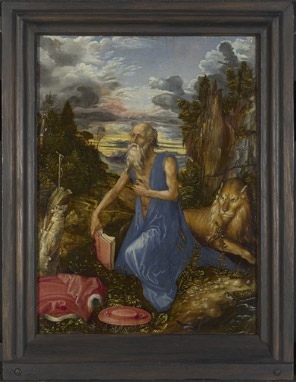Masters of the German Renaissance: York academic curates National Gallery exhibition
University of York art historian Dr Jeanne Nuechterlein is co-curator of a major exhibition on the masters of the German Renaissance at the National Gallery this month.
Part of a collaboration between the National Gallery and the University, the exhibition will take a fresh look at German Renaissance paintings in the National Gallery collection. It will provide insights into the way the works were perceived in their time and in the recent past, and how they are seen today.
Dr Nuechterlein is working with Susan Foister, the Deputy Director and Curator of German Painting at the National Gallery, and Arts and Humanities Research Council (AHRC) collaborative doctoral student Nicola Sinclair, to create the exhibition.

Hans Holbein the Younger (1497/8 - 1543): Jean de Dinteville and Georges de Selve ('The Ambassadors'), 1533
Oil on oak, The National Gallery, London
© The National Gallery, London
Running from 19 February until 11 May, ‘Strange Beauty: Masters of the German Renaissance’ will focus on some of the best-known artists of the period, including Hans Holbein the Younger, Albrecht Dürer and Lucas Cranach the Elder. The exhibition will highlight the ways in which their paintings, drawings and prints were valued in the 16th century for qualities such as expression and inventiveness.
The exhibition will also examine why attitudes towards the German Renaissance were mixed in the 19th and early 20th centuries. While some admired the artists’ technical mastery and their embodiment of a perceived German national identity, others saw these works of art as excessive or even ugly – particularly when compared with works of the Italian Renaissance. The final room of the exhibition will invite visitors to share their own reactions and reflect on how we evaluate art today.
Senior lecturer Dr Nuechterlein, an expert in Northern European Art, said: “The partnership between the National Gallery and the Department of History of Art at York has provided a wonderful opportunity to develop new research culminating in this exhibition. The project also fosters the next generation of scholars by supporting Nicola’s important contribution to our research. It has been for me a great pleasure to work with Susan and the entire team at the Gallery. Our research strengths have dovetailed perfectly to open up new insights into the fascinating history of German art at the National Gallery, and we are excited about inviting the public to take part in our discoveries.”

Albrecht Dürer (1471 - 1528): Saint Jerome, about 1496
Oil on pearwood, The National Gallery, London
© The National Gallery, London
The German Renaissance was part of the cultural and artistic awakening that spread across Northern Europe in the 15th and 16th centuries. German artists such as Dürer and Holbein developed an international reputation, their fame reaching all parts of Europe. However, by the time the National Gallery was founded in 1824, British collectors took little interest in these artists. It was not until the 1960s, in a post-war era of new cultural tastes, that the Gallery actively expanded its German collection.
A highlight of the exhibition will be a reconstruction of the Liesborn altarpiece. This work was created after 1465 and originally formed the high altarpiece in the Benedictine Abbey of Liesborn in Germany. In 1803, on the suppression of the monastery, it was dismembered, and its remaining parts were acquired by the National Gallery in 1854. But several pieces were soon sold on, and only eight pieces remain in London as part of the Krüger Collection. Now for the first time, visitors will be able to visualise the full altarpiece as it might have looked during the 15th century.
The exhibition ‘Strange Beauty: Masters of the German Renaissance’ will run at the National Gallery from 19 February until 11 May. For further information visit www.nationalgallery.org.uk/whats-on/exhibitions/strange-beauty
Further information
- Dr Jeanne Nuechterlein joined the University of York in October 2000 and is a member of York’s interdisciplinary Centre for Medieval Studies and the Centre for Renaissance and Early Modern Studies. Her research focuses on religious and secular imagery in the late medieval and early modern periods, particularly the cultural role of art for its makers, patrons and viewers.
- Read more about Dr Jeanne Nuechterlein’s research at www.york.ac.uk/history-of-art/staff/nuechterlein/
- More information on the University of York’s Department of History of Art at www.york.ac.uk/history-of-art/
- The Arts and Humanities Research Council (AHRC) funds world-class, independent researchers in a wide range of subjects: ancient history, modern dance, archaeology, digital content, philosophy, English literature, design, the creative and performing arts, and much more. This financial year the AHRC will spend approximately £98m to fund research and postgraduate training in collaboration with a number of partners. The quality and range of research supported by this investment of public funds not only provides social and cultural benefits but also contributes to the economic success of the UK. www.ahrc.ac.uk
